The 2012 MacBook Air (11 & 13-inch) Review
by Anand Lal Shimpi on July 16, 2012 12:53 PM EST- Posted in
- Apple
- Mac
- MacBook Air
- Laptops
- Notebooks
The More Complicated (yet predictable) SSD Lottery
Apple continues to use a custom form factor and interface for the SSDs in the MacBook Air. This generation Apple opted for a new connector, so you can't swap drives between 2011 and 2012 models. I'd always heard reports of issues with the old connector from a manufacturing standpoint, so the change makes sense. The new SSD connector looks to be identical to the one used by the Retina Display equipped MacBook Pro, although rest of the SSD PCB is different.

The Toshiba Branded SandForce SF-2200 controller in the 2012 MacBook Air - iFixit
As always there are two SSD controller vendors populating the drives in the new MacBook Air: Toshiba and Samsung. The Samsung drives use the same PM830 controller found in the 2012 MacBook Pro as well as the MacBook Pro with Retina Display. The Toshiba drives use a rebranded SandForce SF-2200 controller. Both solutions support 6Gbps SATA and both are capable of reaching Apple's advertised 500MB/s sequential access claims.
While in the past we've recommended the Samsung over the Toshiba based drives, things are a bit more complicated this round because of the controller vendor Toshiba decided to partner with.

The write/recycle path in NAND flash based SSD
Samsung's PM830 works just like any other SSD controller. To the OS it presents itself as storage with logical block addresses starting from 0 all the way up to the full capacity of the drive. Reads and writes come in at specific addresses, and the controller maps those addresses to blocks and pages in its array of NAND flash. Every write that comes in results in data written to NAND. Those of you who have read our big SSD articles in the past know that NAND is written to at the page level (these days pages are 8KB in size), but can only be erased at the block level (typically 512 pages, or 4MB). This write/erase mismatch combined with the fact that each block as a finite number of program/erase cycles it can endure is what makes building a good SSD controller so difficult. In the best case scenario, the PM830 will maintain a 1:1 ratio of what the OS tells it to write to NAND and what it actually ends up writing. In the event that the controller needs to erase and re-write a block to optimally place data, it will actually end up writing more to NAND than the OS requested of it. This is referred to as write amplification, and is responsible for the performance degradation over time that you may have heard of when it comes to SSDs.
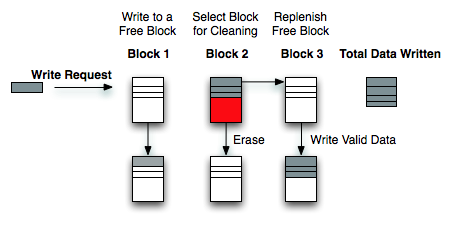
Write Amplification
For most client workloads, with sufficient free space on your drive, Samsung's PM830 can keep write amplification reasonably low. If you fill the drive and/or throw a fragmented enough workload at it, the PM830 doesn't actually behave all that gracefully. Very few controllers do, but the PM830 isn't one of the best in this regard. My only advice is to try and keep around 20% of your drive free at all times. You can get by with less if you are mostly reading from your drive or if most of your writes are just big sequential blocks (e.g. copying big movies around). I explain the relationship between free space and write amplification here.

Write Amplification vs. Spare Area, courtesy of IBM Zurich Research Laboratory
The Toshiba controller works a bit different. As I already mentioned, Toshiba's controller is actually a rebranded SandForce controller. SandForce's claim to fame is the ability to commit less data to NAND than your OS writes to the drive. The controller achieves this by using a hardware accelerated compression/data de-duplication engine that sees everything in the IO stream.
The drive still presents itself as traditional storage with an array of logical block addresses. The controller still keeps track of mapping LBAs to NAND pages and blocks. However, because of the compression/dedupe engine, not all data that's written to the controller is actually written to NAND. Anything that's compressible, is compressed before being written. It's decompressed on the fly when it's read back. All of the data is still tracked, the drive still is and appears to be the capacity that is advertised (you don't get any extra space), you just get extra performance. After all, writing nothing is always faster than writing something.
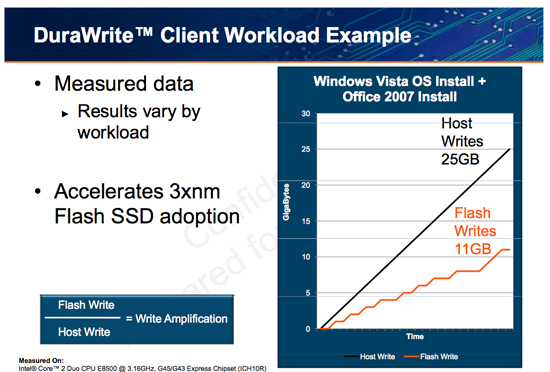
Writing less data to NAND can improve performance over time by keeping write amplification low. There are also impacts on NAND endurance, but as I've shown in the past, endurance isn't a concern for client drives and usage models. Writing less also results in a slight reduction in component count: there's no external DRAM found on SandForce based drives. The PM830 SSD features a 256MB DDR2 device on-board, while the Toshiba based drive has nothing - just NAND and the controller. This doesn't end up making the Toshiba drive substantially cheaper as SandForce instead charges a premium for its controller. In the case of the PM830, both user data and LBA-to-NAND mapping tables are cached in DRAM. In the case of the Toshiba drive, a smaller on-chip cache is used since there's typically less data being written to the NAND itself.
SandForce's approach is also unique in that performance varies depending on the composition of the data written to the drive.
PC users should be well familiar with SandForce's limitations, but this is the first time that Apple has officially supported the controller under OS X. As such I thought I'd highlight some of the limitations so everyone knows exactly what they're getting into.
Any data that's random in composition, or already heavily compressed, isn't further reduced by Toshiba's SandForce controller. As SandForce's architecture is designed around the assumption that most of what we interact with is easily compressible, when a SF controller encounters data that can't be compressed it performs a lot slower.
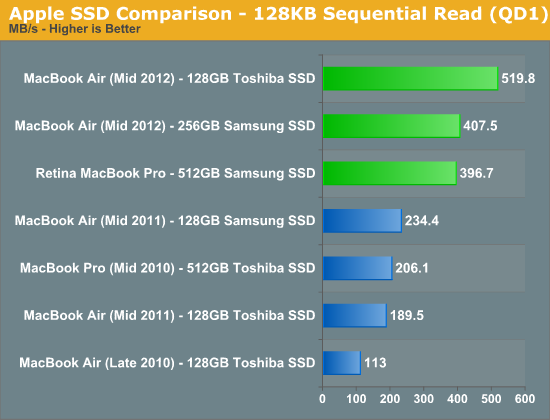
Special thanks to AnandTech reader KPOM for providing the 256GB Samsung results
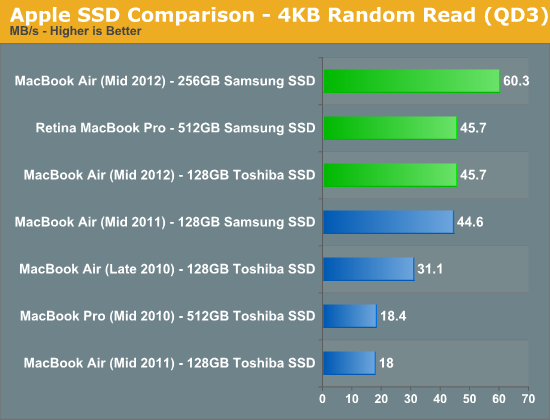
The performance impact is pretty much limited to writing. We typically use Iometer to measure IO performance as it's an incredibly powerful tool. You can define transfer size, transfer locality (from purely sequential all the way to purely random) and even limit your tests to specific portions of the drive, among other features. Later versions of Iometer introduced the ability to customize the composition of each IO transfer. For simplicity, whenever Iometer goes to write anything to disk it's a series of repeating bytes (all 0s, all 1s, etc...). Prior to SandForce based SSDs this didn't really matter. SandForce's engine will reduce these IOs to their simplest form. A series of repeating bytes can easily be represented in a smaller form (one byte and a record of how many times it repeats). Left at its default settings, SandForce drives look amazing in Iometer - even faster than the PM830 based Samsung drive that Apple uses. Even more impressive, since very little data is actually being written to the drive, you can run default Iometer workloads for hours (if not days) on end without any degradation in performance. Doing so only tells us part of the story. While frequently used OS and application files are easily compressed, most files aren't.
Thankfully, later versions of Iometer include the ability to use random data in each transfer. There's still room for some further compression or deduplication, but it's significantly reduced. In the write speed charts below you'll see two bars for the Toshiba based SSD, the one marked incompressible uses Iometer's random data setting, the other one uses the default write pattern.
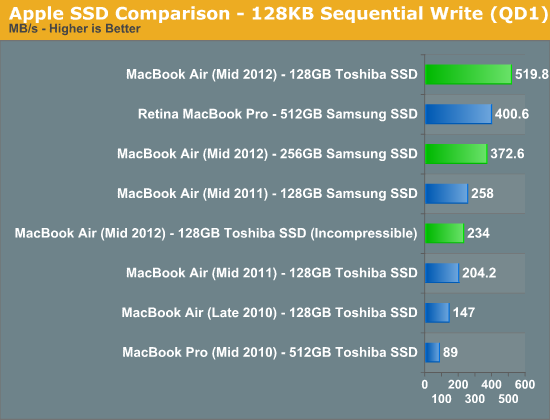
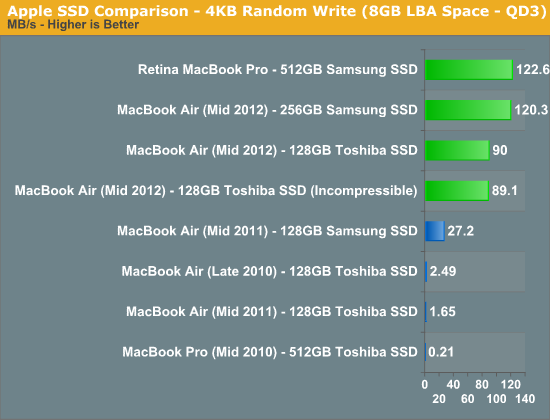
When fed easily compressible data, the Toshiba/SandForce SSD performs insanely well. Even at low queue depths it's able to hit Apple's advertised "up-to" performance spec of 500MB/s. Random write performance isn't actually as good as Samsung's, but it's more likely to maintain these performance levels over time.
Therein lies the primary motivator behind SandForce's approach to flash controller architecture. Large sequential transfers are more likely to be heavily compressed (e.g. movies, music, photos), while the small, pseudo-random accesses are more likely easily compressible. The former is rather easy for a SSD controller to write at high speeds. Break up the large transfer, stripe it across all available NAND die, write as quickly as possible. The mapping from logical block addresses to pages in NAND flash is also incredibly simple. Fewer entries are needed in mapping tables, making the read and write of these large files incredibly easy to track/manage. It's the small, pseudo-random operations that cause problems. The controller has to combine a bunch of unrelated IOs in order to get good performance, which unfortunately leaves the array of flash in a highly fragmented state - bringing performance down for future IO operations. If SandForce's compression can reduce the number of these small IOs (which it manages to do very well in practice), then the burden really shifts to dealing with large sequential transfers - something even the worst controllers can do well.
It's really a very clever technology, one that has been unfortunately marred by a bunch of really bad firmware problems (mostly limited to PCs it seems).
The downside in practice is the performance when faced with these incompressible workloads. Our 4KB random write test doesn't actually drop in performance, but if we ran it for long enough you'd see a significant decrease in performance. The sequential write test however shows an immediate reduction of more than half. If you've been wondering why your Toshiba SSD benchmarks slower than someone else's Samsung, check to see what sort of data the benchmark tool is writing to the drive. The good news is that even in this state the Toshiba drive is faster than the previous generation Apple SSDs, the bad news is the new Samsung based drive is significantly quicker.
What about in the real world? I popped two SSDs into a Promise Pegasus R6, created a RAID-0 array, and threw a 1080p transcode of the Bad Boys Blu-ray disc on the drive. I then timed how long it took to copy the movie to the Toshiba and Samsung drives over Thunderbolt:
| Real World SSD Performance with Incompressible Data | ||||
| Copy 13870MB H.264 Movie | 128GB Toshiba SSD | 512GB Samsung SSD | ||
| Transfer Time | 59.97 s | 31.59 s | ||
| Average Transfer Rate | 231.3 MB/s | 439.1 MB/s | ||
The results almost perfectly mirrored what Iometer's incompressible tests showed us (which is why I use those tests so often, they do a good job of modeling the real world). The Samsung based Apple SSD is able to complete the file copy in about half the time of the Toshiba drive. Pretty much any video you'd have on your machine will be heavily compressed, and as a result will deliver the worst case performance on the Toshiba drive.
Keep in mind that to really show this difference I had to have a very, very fast source for the transfer. Unless you've got a 6Gbps SSD over USB 3.0 or Thunderbolt, or a bunch of hard drives you're copying from, you won't see this gap. The difference is also less pronounced if you're copying from and to the same drive. Whether or not this matters to you really depends on how often you move these large compressed files around. If you do a lot of video and photo work with your Mac, it's something to pay attention to.
There's another category of users who will want to be aware of what you're getting into with the Toshiba based drive: anyone who uses FileVault or other full disk encryption software.
Remember, SandForce's technology only works on files that are easily compressed. Good encryption should make every location on your drive look like a random mess, which wreaks havoc on SandForce's technology. With FileVault enabled, all transfers look incompressible - even those small file writes that I mentioned are usually quite compressible earlier.
After enabling FileVault I ran our Iometer write tests on the drives again, performance is understandably impacted:
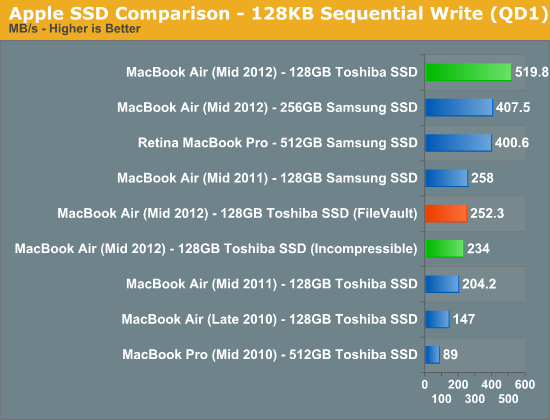
Also look at what happens to our 4KB random write test if we repeat it a few times back to back:
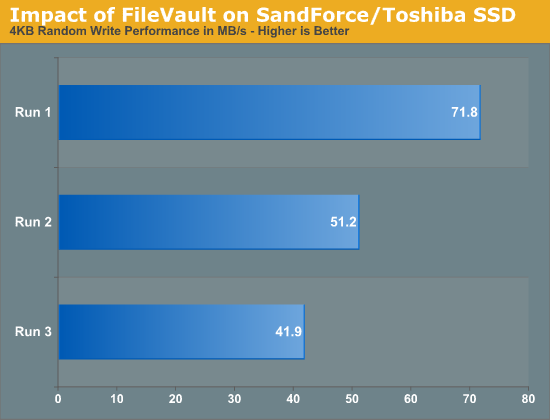
That trend will continue until the drive's random write performance is really bad. Sequential write passes will restore performance up to ~250MB/s, but it takes several passes to get it there:
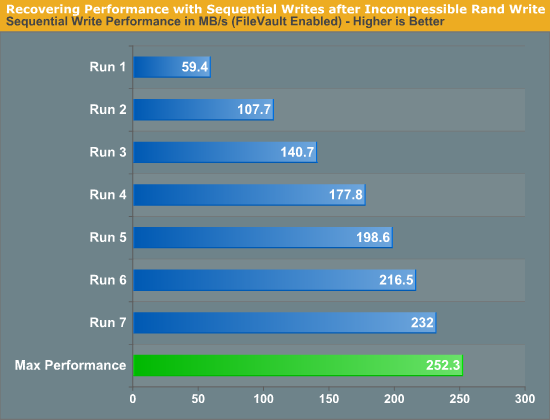
If you're going to be using FileVault, stay away from the Toshiba drive.
This brings us to the next problem: how do you tell what drive you have?
As of now Apple has two suppliers for the SSD controllers in all of its 2012 Macs: Toshiba and Samsung. If you run System Information (click the Apple icon in the upper left > About this Mac > System Report) and select Serial ATA you'll see the model of your SSD. Drives that use Toshiba's 6Gbps controller are labeled Apple SSD TSxxxE (where xxx is your capacity, e.g. TS128E for a 128GB drive), while 6Gbps Samsung drives are labeled Apple SSD SMxxxE. Unfortunately this requires you to already purchase and open up your system. It's a good thing that Apple stores are good about accepting returns.
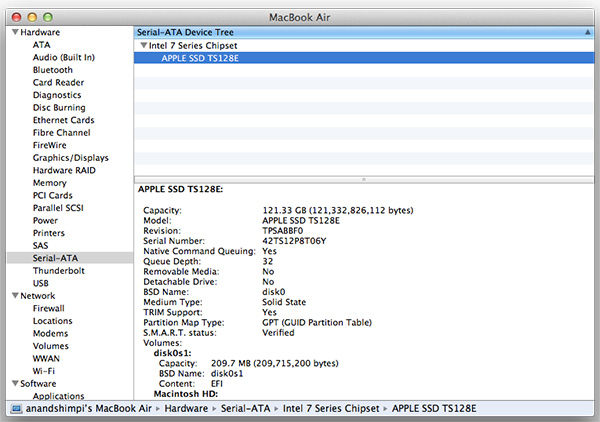
There's another option that seems to work, for now at least. It seems as if all 256GB and 512GB Apple SSDs currently use Samsung controllers, while Toshiba is limited to the 64GB and 128GB capacities. There's no telling if this trend will hold indefinitely (even now it's not a guarantee) but if you want a better chance of ending up with a Samsung based drive, seek out a 256GB or larger capacity. Note that this also means that the rMBP exclusively uses Samsung controllers, at least for now.
I can't really blame Toshiba for this as even Intel has resorted to licensing SandForce's controllers for its highest performing drives. I will say that Apple doesn't seem to be fond of inconsistent user experiences across its lineup. I wouldn't be surprised if Apple sought out a third SSD vendor at some point.










190 Comments
View All Comments
MrJim - Tuesday, July 17, 2012 - link
Thanks for the reply sir!I would like "ultra small form factor removable DRAM standards" and i think many of us would. But it also seems for me that this is part of a corporate strategy, car makers have done this for years. "You can only buy stuff from us, good quality we promise, and of course alot more expensive than some of the other 200 makers of that perticulur car engine part".
To say the least for changing batteries. And i did expect you to sit on information that we ordinary people doesnt have. Im looking forward to the future, but i like choice thats all.
Karltheghost - Tuesday, July 17, 2012 - link
Sure you're right. If i buy a Notebook, it is less serviceable than a full size desktop PC. And if i buy an Ultrabook it is even less serviceable. But being able to change the only wearing part in an expensive part of Elecronics, that is not likely to last as long as the rest of the Laptop is the least i want to do. By the way it's the same for Smartphones. I just don't want to buy a product which i need to replace completely if the battery wears out because i cannot change it myself and having it replaced is nearly as expensive as a new Laptop/Smartphone. And because there are manufactors who sell Smartphones and Ultrabooks with changeable batteries, your argument, as far as it goes to batteries, is not very convincing. As for other parts you're right, demanding switchable CPUs or something like that in an Ultrabook would be hilarious.KPOM - Tuesday, July 17, 2012 - link
There are more and more Ultrabooks sold with non removable batteries now. The Samsung Series 9 is one example.Tegeril - Monday, July 16, 2012 - link
"Very disappointed Anand. Very disappointed with you."Hilarious.
The MBA is still a class leading entry in the ultraportable market. It no longer wins in every single category (see: display), but that does not mean it is not a great system.
You ignore things like consumer SSDs being consumer SSDs in large packages without custom manufacturing. Apple's memory upgrades have always been more expensive than retail and have actually come closer to reality recently. But again, this is not a stick of mass produced memory, it's not an apples to apples comparison. As far as overcharging in any other area of the system, you fail to accurately include chassis, trackpad, magsafe, and other superior elements that can't be compared in the way you want to do spec to spec comparisons.
Being melodramatic about this review is what's disappointing. It very accurately describes why Apple is selling these and their pro systems so much more successfully than in the past. They're very good systems.
KoolAidMan1 - Monday, July 16, 2012 - link
The Apple haters are out in force, as usual.So mad.
Karltheghost - Tuesday, July 17, 2012 - link
So everyone who criticises Apple is automatically a hater? Seems like you're as differenciating as the haters . . . In fact, there are plenty of people out there who had an apple product and are therefore not very fond of apple. For example i bought an Ipod because i wanted a good Mp3-player. It did everything except from playing Mp3s in a proper way and i wasn't the only one who had this issue (Referring to an Ipod nano 3g, the bad sound without equalizer and the scratching noises with equalizer turned on).And i know a lot of people who sold their Macbook Pros 2 weeks after purchasing and bought regular windows machines because there are flaws that the technical specs don't reveal . . .
KPOM - Tuesday, July 17, 2012 - link
"Macs are garbage and I should know because I bought an iPod once and it didn't work right, plus my friend returned a MacBook Pro 2 weeks after buying it." These are anecdotes.It's OK to criticize Apple. Heck, the original MacBook Air got a lot of criticism from hard core Mac fans when it first came out. However, few company's products inspire the fierce criticism that anything Apple puts out does.
I get the sense that if Apple stuck its logo on hardware completely identical to an ASUS Zenbook or Samsung Series 9, there would be 6 pages of comments on this site from many of the Apple bashers criticizing every little flaw, but when the actual product reviews come out those same people won't be posting anything but praise for the product.
Karltheghost - Tuesday, July 17, 2012 - link
Of course that are anecdotes, hence i wrote "For example" at the beginning . . .But actually i rely more on my personal experience and that of others, by whom i know what they're doing with their stuff than on some fanboyspeech (this is not intendet as criticism for this review). What i can say is that i made bad experiences with apple and friends too and there are much more bad experiences than good ones. So i am very sceptical. On the other hand i had very bad experiences with other brands too (e.g. i had 2 HP Notebooks that lastet less than 3 months), but there are plenty of others who hadn't problems for years. So what i'm referring to is kind of a good/bad-balance . . .
It's not that i wouldn't buy a product just because it has an apple on it. In fact i would buy one if it fulfills my needs. But as long they're charging premium prices for machines that you can literarily throw away as soon the warranty runs out and have horrible software restrictions i'll stick with the bulky, ugly things that other manufactures are producing
KPOM - Tuesday, July 17, 2012 - link
What makes an Apple a throwaway product after a year? It still functions. My sister has a 2006 MacBook that is in almost new condition (though she hasn't used it much since getting a 2011 MacBook Air).Also, there are no software restrictions on OS X. Even with Mountain Lion, you can purchase and install your own software. This isn't iOS or Windows RT, where you must purchase from an App Store. The Mac App Store is optional.
Sure, it won't run Windows as good as a PC with the same specs will, but it will run pretty well. I think what most Mac users who run Windows find is that over time, they use Windows less and less, perhaps just for that old program that just doesn't have a Mac equivalent. Heck, even Windows 7 includes an "XP Mode" to run XP in virtualization, so it isn't unique to the Mac. I can quibble a lot about how Microsoft has "crippled" support for 16-bit apps, or how the 64-bit version dropped support for some old peripheral that worked just fine in XP.
Karltheghost - Tuesday, July 17, 2012 - link
Just personal experience. After 2 Years or so most products get faulty, even if it's just the battery or a fan. On most Apple products you can't change that yourself as it's tightly integrated in the system and for example, a friend of mine payed 170€ just for a new iphone battery . Thats a financial write-of.With software restrictions i was referring to the windows/linux thing. The only reason windows runs slow is that apple provides bad drivers so you stick with osx.
A bunch of horses won't get me to use OSX, i tried it once and it felt like a cage where the restrictions are covered by a lot bling-bling animation. While there are some nice things about it, like the touchpad integration you have even less system access than under windows. Nothing to convince a linux user and also nothing to replace windows on the gaming machine ;)
The license agreement does the rest (yeah, i actually read that thing)